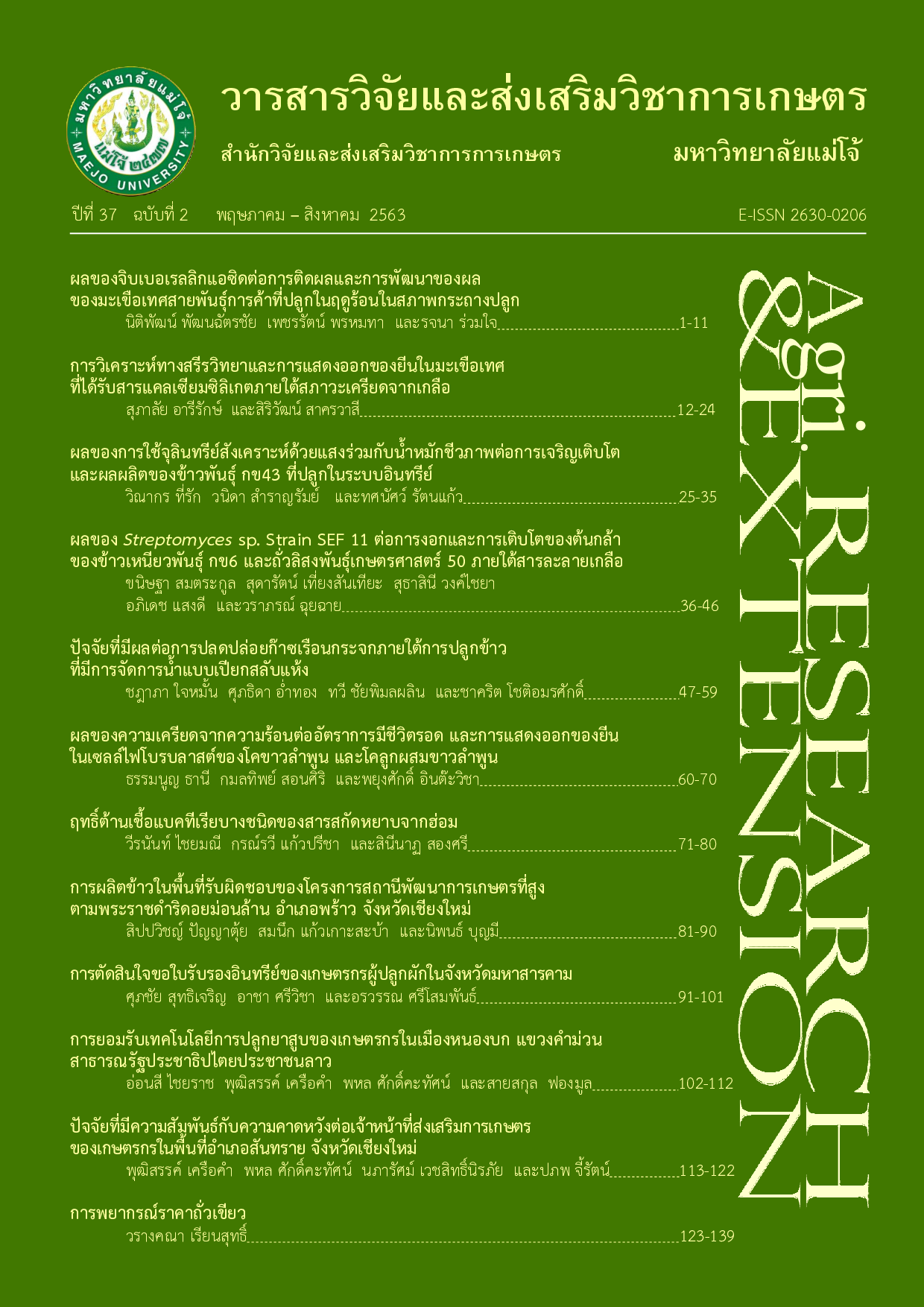ฤทธิ์ต้านเชื้อแบคทีเรียบางชนิดของสารสกัดหยาบจากฮ่อม
คำสำคัญ:
ฮ่อม, สารสกัดหยาบ, ฤทธิ์ต้านเชื้อแบคทีเรีย, Strobilanthes cusia (Nees) Kuntzeบทคัดย่อ
ฮ่อม Strobilanthes cusia (Nees) Kuntze เป็นพืชล้มลุก มีลักษณะเป็นไม้พุ่มขนาดเล็ก นิยมนำมาเป็นวัตถุดิบในการย้อมสีหม้อฮ่อม โดยจังหวัดแพร่มีการปลูกฮ่อมกันในหลายพื้นที่ ซึ่งงานวิจัยนี้ได้ศึกษาฤทธิ์ต้านเชื้อแบคทีเรียของสารสกัดจากส่วนใบ ลำต้น และรากของฮ่อมด้วยตัวทำละลาย 3 ชนิด คือ เฮกเซน ไดคลอโรมีเทน และเอทานอล โดยวิธี Disc diffusion assay พบว่าสารสกัด ไดคลอโรมีเทนของใบฮ่อมที่ความเข้มข้น 0.5 ก./มล. มีฤทธิ์ยับยั้งเชื้อแบคทีเรียทดสอบได้ทุกชนิด โดยเฉพาะเชื้อแบคทีเรีย Staphylococcus aureus และ Bacillus cereus มีความไวต่อสารสกัดใบฮ่อมมากที่สุด โดยมี ขนาดเส้นผ่าศูนย์กลางของบริเวณการยับยั้ง เท่ากับ 20.33-24.67 และ 20.67-22.00 มม. ตามลำดับ เมื่อนำสารสกัด ไดคลอโรมีเทนของใบฮ่อมไปทดสอบหาความเข้มข้นที่ต่ำที่สุด (MIC) ที่สามารถยับยั้งการเจริญของเชื้อแบคทีเรียโดยวิธี Broth microdilution method พบว่า ค่า MIC ของเชื้อ S. aureus และ B. cereus เท่ากับ 256 และ 128 ไมโครกรัม/มล. ตามลำดับ อย่างไรก็ตามสารสกัดจากลำต้นที่ความเข้มข้น 0.1 กรัมต่อมิลลิลิตร และรากที่ความเข้มข้น 0.02 ก./มล. โดยใช้ตัวทำละลายต่างกัน พบว่ามีประสิทธิภาพในการยับยั้งเชื้อแบคทีเรียแกรมบวกที่นำมาทดสอบได้เท่านั้น ดังนั้นจากงานวิจัยนี้อาจจะเป็นแนวทางในการนำฮ่อมมาพัฒนาเพื่อใช้ประโยชน์ด้านอื่นมากขึ้น
เอกสารอ้างอิง
Chinese Pharmacopoeia Commission. 2015. The Pharmacopoeia of the People’s Republic of China, 2015 Edition Part I. Beijing: China Medical Science Press. 2185 p.
Clinical and Laboratory Standards Institute(CLSI). 2012. Methods for dilution antimicrobial susceptibility tests for bacteria that grow aerobically, ninth ed. Approved standard 32(2): 68.
Flesar, J., J. Havlik, P. Kloucek, V. Rada, D. Titera, B. Michal, M. Stropnicky and L. Kokoska. 2010. In vitro growth-inhibitory effect of plant-derived extracts and compounds against Paenibacillus larvae and their acute oral toxicity to adult honey bees. Vet. Microbiol. 145: 129-133.
Gu, W., Y. Zhang, X.J. Hao, F.M. Yang, Q.Y. Sun, S.L. Morris-Natschke, K.H. Lee, Y.H. Wang and C.L. Long. 2014. Indole alkaloid glycosides from the aerial parts of Strobilanthes cusia. J. Nat. Prod. 77: 2590-2594.
Honda, G. and M. Tabata. 1979. Isolation of antifungual principle tryptanthrin, from Strobilanthes cusia O. Kuntze. Planta Med. 36: 85-90.
Ichimaru, Y., H. Saito, T. Uchiyama, K. Metori, K. Tabata, T. Suzuki and M. Shinichi. 2015. Indirubin 3’-(O-oxiran-2-ylmethyl) oxime: a novel anticancer agent. Bioorg. Med. Chem. Lett. 25: 1403-1406.
Li, L., H.Q. Liang, S.X. Liao, C.Z. Qiao, G.J. Yang and T.Y. Dong. 1993. Chemical studied of Strobilanthes cusia. Acta Pharm. Sin. 28: 238-240. (Chinese with English abstract)
Merz, K.H., S. Schwahn, F. Hoppe, S. Muhbeyer, S. Jakobs and G. Eisenbrand. 2004. Novel indirubin derivatives, promising anti-tomor agents inhibiting cyclin-dependent kinases. Int. J. Clin. Pharmacol. Ther. 42: 656-658.
Panichakul, T., N. Boohuad, K. Jantree, T. Kulchanaphakawat, P. Patumasut, R. Rungruang and N. Onvimol. 2017. Antibacterial activity of Rhinacanthus nasutus (L.) Kurz extract against bacteria with dermatologic relevance. SDU Res. J. 10(3): 17-32. [in Thai]
Rungsriphanurat, W., P. Kammarnjassadakul and I. Chanwitthayanuchit. 2016. Antibacterial activities of ten Thai herbal extracts against Staphylococcus aureus ATCC 25923, Bacillus cereus and Escherichia coli ATCC 25922. HCU Journal 38: 35-48. [in Thai]
Scherrer, R. and P. Gerhardt. 1971. Molecular sieving by the Bacillus megaterium cell wall and protoplast. J. Bacteriol. 107: 718-735.
Shahni, R. and P.J. Handique. 2013. Antibacterial properties of leaf extracts of Strobilanthes cusia (Nees) Kuntze, a rare ethno-medicinal plant of Manipur, India. Int. J. Pharm. Tech. Res. 5: 1281-1285.
Shan, B., Y-Z. Cai, J.D. Brooks and H. Corke. 2007. The in vitro antibacterial activity of dietary spice and medicinal herb extracts. Int. J. Food Microbiol. 117: 112-119.
Shimanuki, H. and K. David. 1991. Diagnosis of Honeybee Disease. Riverdale: United States Department of Agriculture. 63 p.
Sun, X.B., J.R. Sheng and D.P. Wang. 2008. Research progress of chemical constituents and pharmacological activities for Baphicacanthus cusia (Nees) Bremek. Guangxi Shifan Xueyuan Xuebao 25: 66-69.
Tanaka, T., T. Ikeda, M. Kaku, X-H. Zhu, M. Okawa, K. Yokomizo, M. Uyeda and T. Nohara. 2004. A new lignin glycoside and phenylethanoid glycosides from Strobilanthes cusia Bremek. Chem. Pharm. Bull. 52: 1242-1245.
ดาวน์โหลด
เผยแพร่แล้ว
รูปแบบการอ้างอิง
ฉบับ
ประเภทบทความ
สัญญาอนุญาต
บทความนี้ได้รับการเผยแพร่ภายใต้สัญญาอนุญาต Creative Commons Attribution-NonCommercial-NoDerivatives 4.0 International (CC BY-NC-ND 4.0) ซึ่งอนุญาตให้ผู้อื่นสามารถแชร์บทความได้โดยให้เครดิตผู้เขียนและห้ามนำไปใช้เพื่อการค้าหรือดัดแปลง หากต้องการใช้งานซ้ำในลักษณะอื่น ๆ หรือการเผยแพร่ซ้ำ จำเป็นต้องได้รับอนุญาตจากวารสาร





